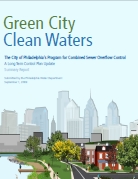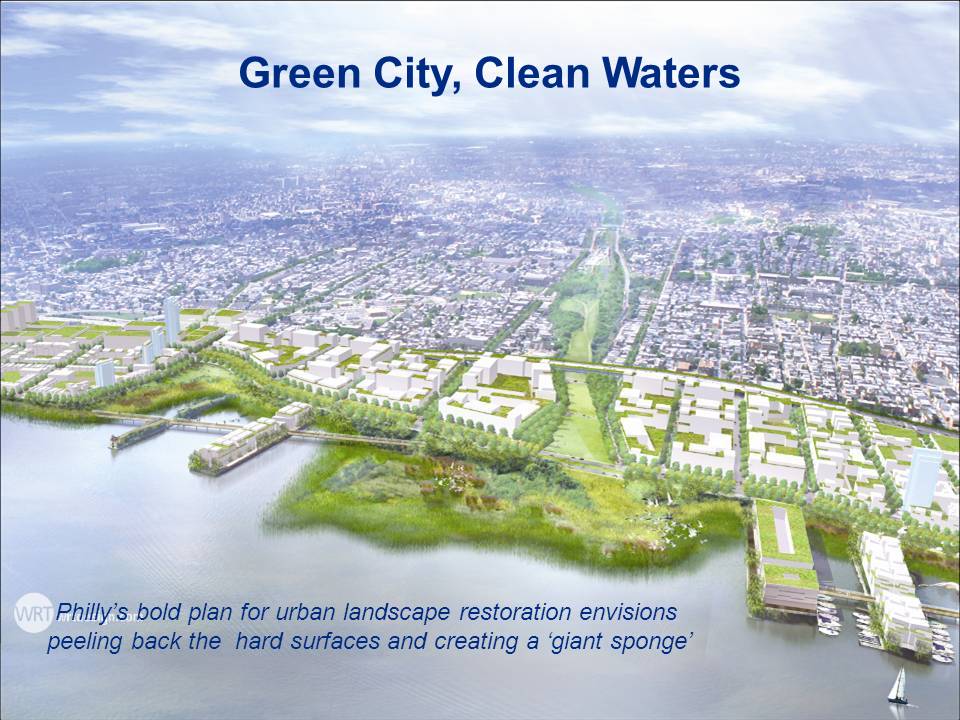Philadelphia's bold plan for rainwater/stormwater management envisions "giant sponge"
Vision for a Green Oasis
Philadelphia has developed a US$1.6 bllion plan to transform the city over the next 20 years by managing and using rainwater instead of just sending it streaming into sewers and rivers as fast as possible.
 “The plan reimagines the city as an oasis of rain gardens, green roofs, permeable pavements, thousands of additional trees, and more. The idea is to turn the city into a giant sponge to absorb as much rainwater as possible and delay the rest in its journey to the nearby Delaware and Schuykill rivers,” writes Korky Koroluk, an Ottawa-based freelance writer.
“The plan reimagines the city as an oasis of rain gardens, green roofs, permeable pavements, thousands of additional trees, and more. The idea is to turn the city into a giant sponge to absorb as much rainwater as possible and delay the rest in its journey to the nearby Delaware and Schuykill rivers,” writes Korky Koroluk, an Ottawa-based freelance writer.
“The new plan announced last month would ‘peel back’ a lot of the city’s concrete and asphalt and replace them with plants — rain gardens, green roofs, landscaped swales in parking lots, heavily planted boulevards, and small wetlands.”
To Learn More:
Click here to read the complete article as published in Korky Koroluk’s Construction Corner column in the Daily Commercial News and Construction Record.
Click here to download a copy of Green City, Clean Waters.
Green City, Clean Waters
“This is the most significant use of green infrastructure I’ve seen in the country, the largest scale I’ve seen,” stated Jon Capacasa, regional director of water protection for the U.S. Environmental Protection Agency (EPA), “We commend Philadelphia for breaking the ice.”
Howard Neukrug is the Philadelphia Water Department’s Director of the Office of Watersheds. He says that his department is “changing the way they look at rainwater  and how it is handled. We value water and we’re changing the traditional way stormwater is managed … between homes, businesses and the environment. We are taking that (old, grey infrastructure) barrier down, and are stopping the water from ever hitting the system.”
and how it is handled. We value water and we’re changing the traditional way stormwater is managed … between homes, businesses and the environment. We are taking that (old, grey infrastructure) barrier down, and are stopping the water from ever hitting the system.”
To read more about what Howard Neukrug said, click on A new course: From tunnels to trees. And to download a PDF copy, click here.
City Transformation
“I believe it’s the most significant investment in transforming the city that we’ll see in our lifetimes,” said Patrick Starr, senior vice president of the Pennsylvania Environmental  Council. “It will change the way neighborhoods look, the way many streets and blocks look.”
Council. “It will change the way neighborhoods look, the way many streets and blocks look.”
Either way, cities big and small are watching to see whether Philadelphia can get the plan approved by the United States Environmental Protection Agency and, if so, deliver on its promise.
Calling the plan ”very compelling” and ”the way we need to go,” National Association of Clean Water Agencies Executive Director Ken Kirk said Philadelphians will ultimately ”be using a lot less energy, they will be using the water resources more efficiently, they will be capturing and recharging groundwater under the city, they’ll have less pollution of the rivers.”
To Learn More:
To read a comprehensive article published in the Philadelphia Enquirer, click on Breaking ground with a $1.6 billion plan to tame water.


